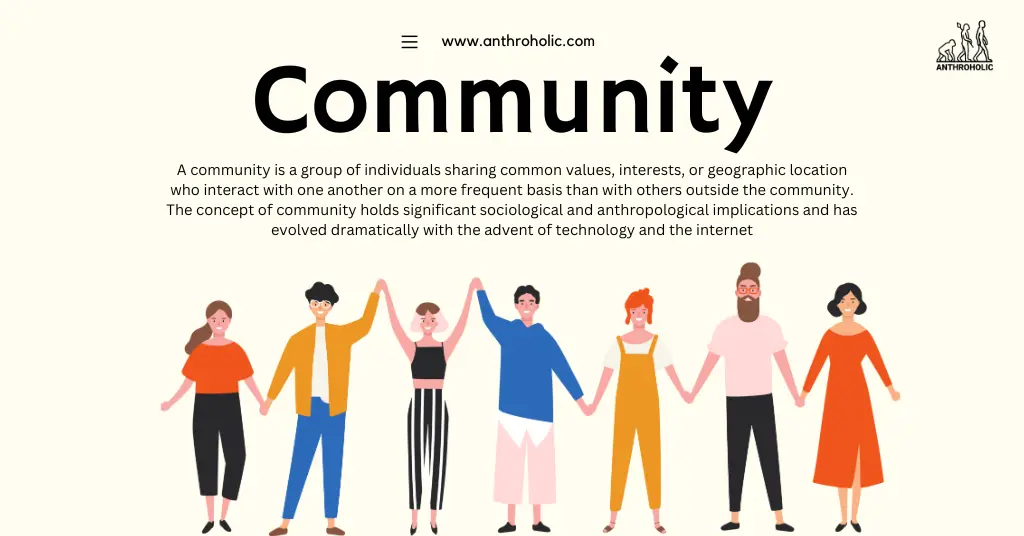Community
A community is a group of individuals sharing common values, interests, or geographic location who interact with one another on a more frequent basis than with others outside the community [1]. The concept of community holds significant sociological and anthropological implications and has evolved dramatically with the advent of technology and the internet [2].

What is a Community?
A community can be characterized by:
- Shared Interests: Members have common interests or goals that bind them together [3].
- Regular Interaction: There’s frequent and meaningful communication among members [3].
- Geographic Proximity or Shared Virtual Space: Traditional communities are often bound by geographic location, while modern communities can exist entirely online [2].
- Emotional Connection: Members feel a sense of belonging and solidarity [4].
Communities are not merely groups of people living together; they represent a deeper level of social connection based on shared experiences, beliefs, or interests.
Types of Communities
There are various types of communities, each characterized by specific traits.
1. Geographical Communities
These are communities that are bound by a shared physical location. This could be a village, town, city, or even a neighborhood. People in geographical communities interact physically on a regular basis and participate in shared local events or issues [5].
2. Communities of Practice
These are groups of people who share a common interest or profession. The members of these communities interact to improve their skills and knowledge. For example, a community of doctors discussing new treatment methods [6].
3. Virtual Communities
With the rise of the internet, virtual communities have become prevalent. These are communities where people interact primarily online. This could be via social media groups, forums, or online gaming communities [7].
4. Communities of Circumstance
These communities come together due to external events or situations, like natural disasters or political movements. They are usually formed out of necessity and dissolve once the situation is resolved [8].
Table 1: Characteristics of Different Types of Communities
| Community Type | Bound by | Interaction Mode | Examples |
|---|---|---|---|
| Geographical | Location | Physical | Towns, Neighborhoods |
| Practice | Profession/Interest | Both Physical and Virtual | Medical community, Academic community |
| Virtual | Internet | Virtual | Social Media Groups, Online Gaming |
| Circumstance | External Situations | Both Physical and Virtual | Disaster Relief Groups, Activist Movements |
Role of Community in Individual and Collective Growth
Communities play a crucial role in the development of individuals and societies.
1. Shared Learning and Skill Development
Communities offer an environment where individuals can learn from each other. This is particularly evident in communities of practice, where members enhance their skills and knowledge [6].
2. Emotional Support and Social Bonding
Communities provide a sense of belonging and emotional support to their members. They can help individuals feel connected, thus reducing feelings of loneliness and isolation [9].
3. Collective Action and Empowerment
Communities can rally together to achieve common goals or tackle shared issues. This collective action can lead to community empowerment and significant societal change [10].
The Role of Communities in Sustainable Development
Communities can also play a pivotal role in promoting sustainable development. Sustainability seeks to balance economic development, social equity, and environmental protection, the so-called ‘triple bottom line.’ Communities offer a perfect setting to foster such a balance due to their shared values and collective action capabilities.
1. Economic Development
Local communities can significantly contribute to economic growth by promoting local businesses and creating employment opportunities. Such economic activities often lead to improved living standards and reduced poverty levels [11].
2. Social Equity
Communities, by their very nature, promote social interaction, shared responsibilities, and collective action. This leads to a reduction in social inequalities and helps build a more balanced and inclusive society. Effective community engagement can lead to increased participation in decision-making processes and foster social equity [12].
3. Environmental Protection
Communities often rally together to protect their shared environment. This can involve activities like community clean-up programs, tree planting drives, or community-led conservation initiatives. Such efforts contribute significantly to environmental sustainability [13].
The Impact of Technology on Communities
The advent of the internet and digital technologies has profoundly impacted how communities form and operate.
1. Expansion of Community Boundaries
The internet has made it possible to form communities that aren’t bound by geography. Virtual communities can bring together people from across the world, leading to greater diversity and richness in shared experiences and perspectives [14].
2. Increased Accessibility
Online communities offer increased accessibility and inclusivity. People can participate regardless of physical ability, geographic location, or time constraints. This has democratized access to communities and allowed more people to experience the benefits of community membership [15].
3. Evolution of Communication
The modes of communication have significantly evolved with technology. Members of digital communities interact through various online platforms using text, audio, and video, enabling real-time communication across time zones [14].
Conclusion
The concept of “community” is a fundamental aspect of human social structures. While the form of communities may change – from physical neighborhoods to online forums – their core purpose of fostering shared learning, emotional support, and collective action remains the same. The continuous evolution of community structures assures that they remain an essential component of individual and societal growth.
References
[1] McMillan, D. W., & Chavis, D. M. (1986). Sense of community: A definition and theory. Journal of Community Psychology, 14(1), 6-23.
[2] Rheingold, H. (2000). The Virtual Community: Homesteading on the Electronic Frontier. MIT Press.
[3] Putnam, R. D. (2001). Bowling Alone: The Collapse and Revival of American Community. Simon & Schuster.
[4] Sarason, S. B. (1974). The Psychological Sense of Community: Prospects for a Community Psychology. Jossey-Bass.
[5] Yi, H., & Fotheringham, A. S. (2011). The impact of local neighbourhood geodemographics on land-use and land-cover patterns. Computers, Environment and Urban Systems, 35(2), 105-115.
[6] Wenger, E. (1998). Communities of Practice: Learning, Meaning, and Identity. Cambridge University Press.
[7] Preece, J. (2000). Online Communities: Designing Usability and Supporting Sociability. Wiley.
[8] Couto, R. A. (1999). Making Democracy Work Better: Mediating Structures, Social Capital, and the Democratic Prospect. UNC Press Books.
[9] Cacioppo, J. T., & Patrick, W. (2008). Loneliness: Human Nature and the Need for Social Connection. W. W. Norton & Company.
[10] Perkins, D. D., & Zimmerman, M. A. (1995). Empowerment theory, research, and application. American Journal of Community Psychology, 23(5), 569-579.
[11] Zainal, K., Kadir, N. B., Yusoff, Z. B., & Zaman, H. B. (2013). Local community and sustainable livelihoods: A case study of the Cameron Highlands, Malaysia. In Procedia-Social and Behavioral Sciences (Vol. 85, pp. 110-122). Elsevier.
[12] Sirgy, M. J., Phillips, R., & Rahtz, D. (2009). Community Quality-of-Life Indicators: Best Cases III. Springer.
[13] Davenport, M. A., Leahy, J. E., Anderson, D. H., & Jakes, P. J. (2007). Building trust in natural resource management within local communities: A case study of the Midewin National Tallgrass Prairie. Environmental Management, 39(3), 353-368.
[14] Rheingold, H. (2000). The Virtual Community: Homesteading on the Electronic Frontier. MIT Press.
[15] Preece, J. (2000). Online Communities: Designing Usability and Supporting Sociability. Wiley.



